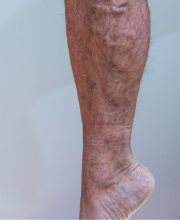 Varicose veins affect approximately 20% of the adult population. They are superficial vessels that are abnormally lengthened, twisted, or dilated, and are seen most often on the legs and thighs. Spider veins have similar features but are smaller.
Varicose veins affect approximately 20% of the adult population. They are superficial vessels that are abnormally lengthened, twisted, or dilated, and are seen most often on the legs and thighs. Spider veins have similar features but are smaller.
Varicose veins bulge and rise above the skin's surface. They may be uncomfortable and result in swelling of the legs. If left untreated, varicose veins may lead to more serious medical problems, such as phlebitis, inflammation, or leg ulcers.
Here are a few answers to frequently asked questions about varicose and spider veins and their treatment from the Stony Brook Vein Center. Our vascular team offers free consultations at the Vein Center to discuss these and other related questions (see contact info below).
Q: What are varicose and spider veins?
A: Varicose veins are enlarged "rope-like" veins — blood vessels — that are swollen and raised above the surface of the skin. They can be flesh-colored, dark purple, or blue, and often look like a cluster of grapes. They are commonly found on the back of the calves or the inside of the legs. However, they can form anywhere on the legs, from groin to ankle.
Spider veins are similar to varicose veins, but they are smaller and closer to the surface of the skin. They are often red or blue, and look like tree branches or spider webs. They can occur anywhere on the legs, and can cover either a very small or very large area of skin. They don't bulge like varicose veins, but are often more noticeable.
Q: What causes varicose veins?
A: Varicose veins result from abnormal inner walls or abnormal valves in these blood vessels. Blood is carried through arteries from the heart to the rest of the body, and returned to the heart through the body's veins, called the venous system. Veins have valves that act as one-way flaps, preventing blood from backing up and pooling. When these one-way valves don't work properly, blood then may flow backwards, causing the veins to dilate (enlarge) and become varicose. The technical terms for this condition are venous reflux or venous insufficiency.
Q: How common are varicose veins and spider veins?
A: More than 80 million Americans suffer from disease of the veins. About 50-55% of women and 40-45% of men suffer from some form of vein problem. Varicose veins affect 1 out of every 2 people older than the age of 50.
Q: What are the risk factors for varicose veins and spider veins?
A: Common risk factors for varicose and spider veins include:
- Increasing age
- Family history
- Pregnancy and hormonal changes
- Obesity
- Prolonged standing
- Prior deep venous thrombosis
Q: What are the signs and symptoms of varicose veins?
A: In many cases, varicose and spider veins cause no symptoms. However, these veins are often unattractive and may become painful. Prolonged sitting or standing tends to make legs with varicose veins feel worse. Some common symptoms of them include:
- Aching pain
- Itching
- Burning
- Leg swelling
- Easily tired legs
- Numbness in the legs
- Leg heaviness
- Darkening of the skin
- Rash on the legs
- Skin ulcers
Q: When to seek medical advice?
A: Self-help measures (conservative therapy) can help ease the pain of varicose veins and may prevent them from getting worse. But if the way they look and feel becomes a concern or if self-help measures are not successful, then it's time to see one of our doctors.
Q: How are varicose and spider veins treated?
A: Several options are available for the treatment of venous reflux (backflow) and varicose veins. Each has its advantages and disadvantages. After your consultation and ultrasound evaluation, our vein specialists will recommend the best plan of treatment for your medical or cosmetic needs.
Q: Does my insurance cover treatment?
A: Most insurance companies cover treatments for varicose veins that are medically necessary, and in cases when conservative therapy with "compression" stockings has failed. Any treatment for cosmetic reasons, including sclerotherapy, is not covered.
Q: How can I get more information?
A: Make an appointment for a free consultation with one of our doctors for answers to more specific questions about your condition: call 631-444-VEIN (8346).

